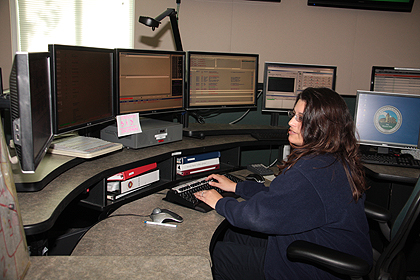
In a short six months, Santa Clara’s emergency call (9-1-1) dispatch center move to Police Department headquarters has demonstrated benefit.
“Communications is so important to us,” says SCPD patrol officer Patti Lynch. “It’s so important to have them in the building. We have a much better relationship. We know them and they know us.” That relationship is one of the keys to SCPD’s average 4-minute response time.
But while every 9-1-1 call comes through this hub, people may not realize that the type of phone system you’re calling on affects what information dispatchers receive – and ultimately, how fast emergency help arrives on the scene.
When a call comes in, explains lead dispatcher Dave Jacobs, dispatchers see the phone number and the type of phone – landline (traditional wired), mobile, or Internet (often called digital, broadband or VoIP phone service). If the call comes from a landline, the address will always be shown.
Many IP phone services – including Vonage, Comcast Digital Voice, and ATT U-Verse Voice – provide 9-1-1 call routing equal to traditional wired phones, but it pays to check with the provider before you need to make that 9-1-1 call.
Cell phones are a different story.
“If you call from a cell phone you have to know where you are,” explains Jacobs bluntly. In most cases, all dispatchers will see is the location of the cell site or base station transmitting the call, although newer phones can provide latitude and longitude, and the methods for pinpointing call location continues to improve. Again, it pays to check with the cell phone provider about emergency calls before you need to make one.
There’s another wrinkle with cell phones, adds SCPD Emergency Communications Operations Manager John Mills. If you call from near a freeway, that 9-1-1 call will go to the California highway patrol first.
Calling from hotel, office, and campus phones – multi-line telephone systems (MLTS) -can also be problematic. That’s because unless the business registers each extension’s physical location – something experts say is uncommon – emergency dispatchers have no way to know where you are. Some phone systems automatically capture handset location, but don’t count on it. All the dispatcher will most likely see is the business’s billing address. And in a big company, that’s probably not where you are.
What’s the impact of that delay?
A one-minute decrease in time-to-care for heart attack victims increases the survival odds almost 60 percent, USA Today reported in 2005. Some 70 percent of PBXs currently in use aren’t configured to display accurate caller location for emergency calls, estimates business phone system giant Avaya. That means many “savable” lives are lost each year, as emergency crews search buildings, shopping malls and airports.
Bottom line: Even in the second decade of the 21st century the traditional landline is still the most reliable connection when it comes to emergencies, says Mills.
For more information about Santa Clara’s 9-1-1 system, visit scpd.org/index.aspx?page=171. To find out more about the challenges and proposed solutions for MLTS in California, visit www.calnena.org/docs.html. Carolyn Schuk can be reached at cschuk@earthlink.net.





